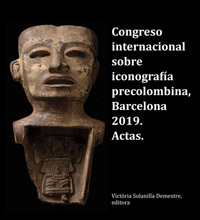Zea E-Books

Congreso internacional sobre iconografía precolombina, Barcelona, 2019. Actas.
Date of this Version
8-20-2020
Document Type
Article
Citation
Publicado en Congreso internacional sobre iconografía precolombina, Barcelona 2019. Actas, Victòria Solanilla Demestre, editora (Lincoln, Nebraska: Zea Books, 2020). https://doi.org/10.32873/unl.dc.zea.1241
Abstract
Una interpretación iconográfica adaptada y adoptada por toda la zona Mississippiana. Cahokia es el asentamiento más antiguo y más grande en la América del Norte precolombina. Situado a pocos kilómetros de la actual ciudad de St. Louis, MO (USA), este sitio arqueológico se convirtió en el mayor asentamiento Mississippiano desde la mitad del siglo XI hasta su abandono, al final del siglo XIV. El modelo cosmológico Mississippiano, trasmitido a través de la iconografía de la cerámica Ramey Incised, generalmente está relacionado con los mundos superior e inferior. Tradicionalmente, se reconoce que la presencia de la cosmógrafia de estilo Cahokiano fuera del American Bottom representa un deseo local de participar en el fenómeno cultural cahokiano. Sin embargo, muchos expertos están de acuerdo en que los habitantes periféricos no adoptaron pasivamente las prácticas de políticas más poderosas sino que, de alguna manera, las reinterpretaron basándose en conocimientos, entendimientos e historias locales.
An iconographic interpretation adapted and adopted across the Mississippian area. Cahokia is the earliest and largest settlement of pre-Columbian North America. Located in the American Bottom floodplain, a few kilometers from present day St. Louis, MO (USA), this archaeological site had risen to be the greatest Mississippian settlement by the middle of the 11th century until its abandonment at the end of the 14th century. The Mississippian cosmological model transmitted through Ramey Incised pottery iconography is generally related to upper and lower worlds. Traditionally, it is granted that the presence of Cahokia-style cosmograms outside of the American Bottom represents a local desire to participate in the Cahokian cultural phenomenon. However, many experts agree that peripheral inhabitants did not passively adopt the practices of more powerful core polities but, in some ways, they reinterpreted them based on local knowledge, understandings and histories.
Included in
American Material Culture Commons, Indigenous Studies Commons, Museum Studies Commons, Other History of Art, Architecture, and Archaeology Commons, Other Languages, Societies, and Cultures Commons


Comments
Copyright 2020 por la autora.